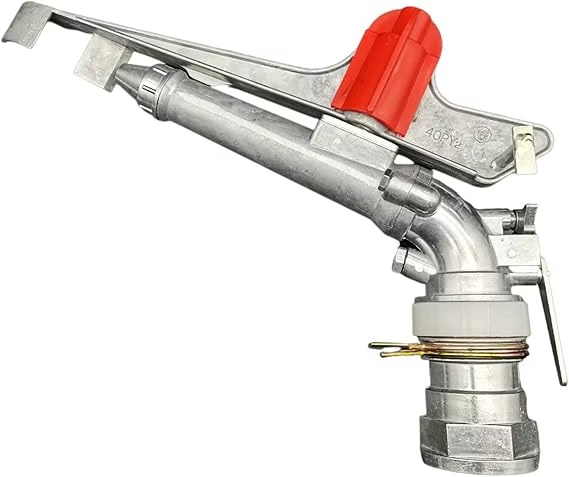
With water conservation raising demand for tools to irrigate land quickly and cover large areas…
The best tool to have that trait is the Rain Gun.
This comprehensive guide will explore everything you need to know about rain guns and how they differ from sprinklers, helping you make an informed decision for your specific irrigation needs.
What is a Rain Gun?
A Rain Gun is a high water pressure irrigation device, or you can categorize it as a cannon or an impact sprinkler, that aims to deliver water to a large area with remarkable efficiency
As the name says, it is a “Rain Gun,” replicating the natural rainfall pattern by creating droplets that fall gently onto crops or landscaped areas.
Rain Guns operate by forcing high-pressure water through specialized nozzles, typically ranging from 3 to 6 kg/cm². This high-pressure system creates a powerful water stream that can cover impressive distances, often reaching 25 to 50 meters in radius, depending on the model and available water pressure.
Applications and Best Use Cases of Rain Gun
Large-Scale Agriculture
Rain Guns are the best choice for large agricultural fields, particularly for crops that benefit from overhead irrigation, such as sugarcane, wheat, and various vegetable and commercial crops.
Dust Suppression
Another use case of the system is its excellent ability to control dust at construction sites, mining operations, and industrial facilities.
Temporary Irrigation
Portability and quick setup traits of Rain Guns are beneficial for construction sites, temporary landscaping projects, and seasonal agricultural operations.
Emergency Irrigation
During drought conditions or irrigation system failures, Rain Guns can provide quick relief for crops and landscapes.
Earlier, I mentioned that Rain Gun is like a sprinkler, but it has significant differences. Here are some of them:
Rain Gun V/S Sprinkler: Detailed Comparison
Coverage Area and Efficiency
Rain Guns can cover more area than traditional sprinkler heads. A single unit of Rain Gun is capable of irrigating 1 to 3 acres of land, depending upon water pressure and nozzle configuration.
Compared to traditional sprinklers, a typical standard rotary sprinkler might cover a radius of 5 to 15 meters, requiring multiple units to achieve the same coverage as a single Rain Gun. However, this smaller coverage area allows for more precise water distribution and better control over irrigation patterns.
Water Pressure Requirements
To cover a large area, Rain Guns need high water pressure. This high-pressure requirement ensures the water stream can travel the necessary distance while maintaining proper droplet formation.
Traditional sprinkler systems are more flexible in their pressure requirements, making them suitable for locations with limited water pressure or smaller pump systems.
Water Distribution Uniformity
Rain Guns create large water droplets that simulate natural rainfall, providing excellent soil penetration and minimal evaporation losses. The droplet size and distribution pattern closely mimic natural precipitation. However, achieving perfectly uniform coverage can be challenging, especially in windy conditions.
Traditional sprinklers, particularly well-designed rotary and spray systems, can provide highly uniform water distribution when properly spaced and operated. The smaller coverage areas allow for overlapping patterns that ensure consistent moisture levels across the entire irrigated area.
Operating Cost and Energy Efficiency
Rain Guns need high water pressure to operate and require powerful motors, which consume more energy per unit of area covered. However, because a single Rain Gun can cover a large area, the overall energy consumption per acre might be competitive with multiple smaller sprinklers.
Sprinkler systems operating at lower pressures generally consume less energy per unit, but multiple units may be required to cover the same area as a single Rain Gun.
Maintenance Requirements
Compared to a complex sprinkler system, Rain Guns have fewer moving parts and components, making them generally easier to maintain. The robust construction needed to handle high pressures also contributes to durability and longevity.
Sprinkler systems, especially those with multiple components, valves, and automated controls, require more regular maintenance. However, individual components are often easier and less expensive to replace when needed.
Now that you’re well aware of what Rain Guns are, how they differ from sprinklers, and their use cases, let’s look at some of the best Rain Guns in the market.
List of Best Rain Guns
Agriculture Farm Irrigation Sprinkler Lawn

There is no specific company behind this Rain Gun; however, the user reviews are great.
This gun covers a wide range of water, and the maximum watering distance is 130 ft. High pressure and safe water, strong and durable.
Made of high-quality zinc alloy material, dustproof, efficient, and long service life.
CDZHLTG Impact Adjustable Water Gun Spray Nozzle
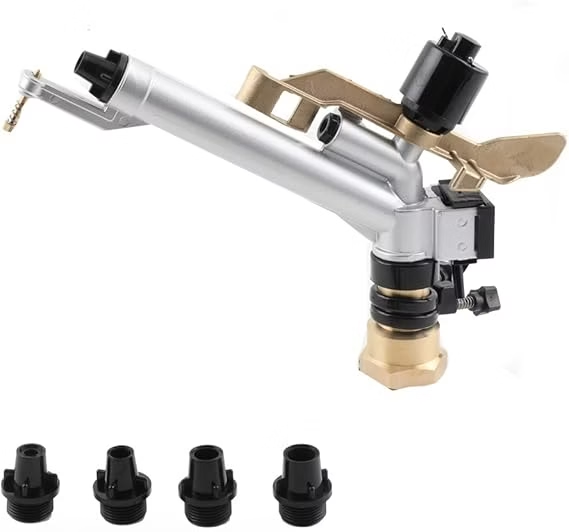
This 1.5-inch adjustable Rain Gun can cover 360 degrees and up to 29 meters.
Compared to the first one, this Rain Gun is not suitable for large fields but is the best choice for greenhouses, plains, fruit trees on hillsides, gardens, growing seedlings, flowers, grass, vegetables, etc.
The Rain Gun comes with a different nozzle set for different use cases.
YIYIBYUS Irrigation Spray Gun
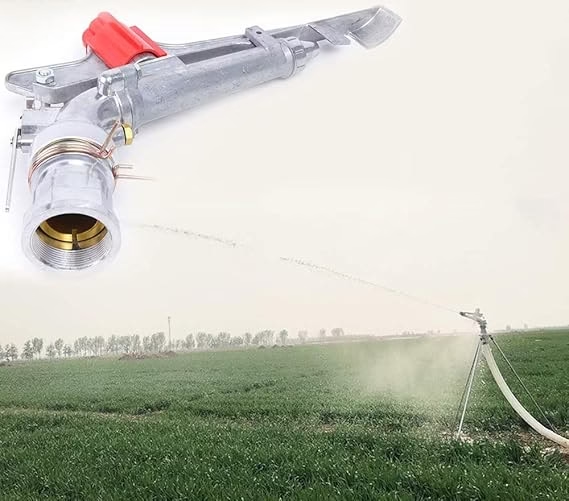
This spray gun covers a 65 to 80-meter area and is mainly used for large-scale agricultural sprinkler irrigation in farms, orchards, tea gardens, forestry, seedlings, wheat, etc.
It can also be used in factories, mines, dust removal, cooling, urban greening, and fire control.
Made with high-quality zinc alloy material—dustproof, efficient, and long-lasting. Easy to use, rugged, and high pressure.
Strongway Wheeled Spray Gun
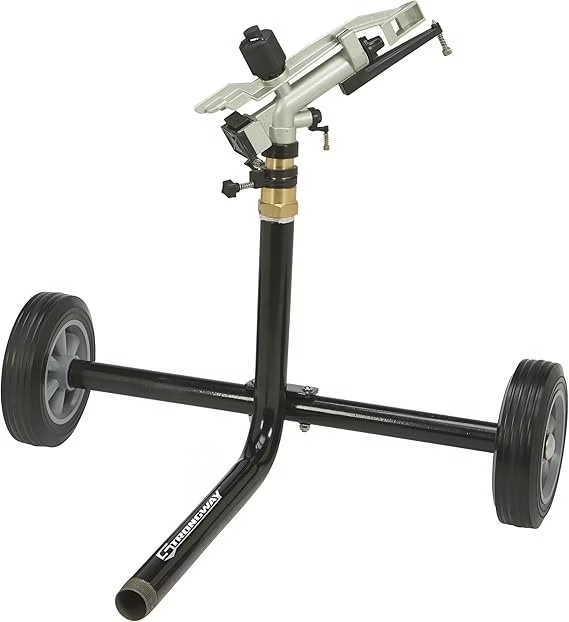
This is unique in this list because it has built-in wheels to move the sprinkler according to your water requirements.
The gun comes with a 5-nozzle setup and an impact-style die-cast aluminum sprinkler head delivering water at a 28° trajectory, covering up to 150 ft. diameter / 17,000 sq. ft. of area.
You can set the spray gun to cover full circle or partial circle patterns.
The wheeled cart is constructed with heavy-gauge 1 1/4 in. steel pipe and 2 wheels for easy mobility.
HIINZI FNPT Full Circle Rain Gun
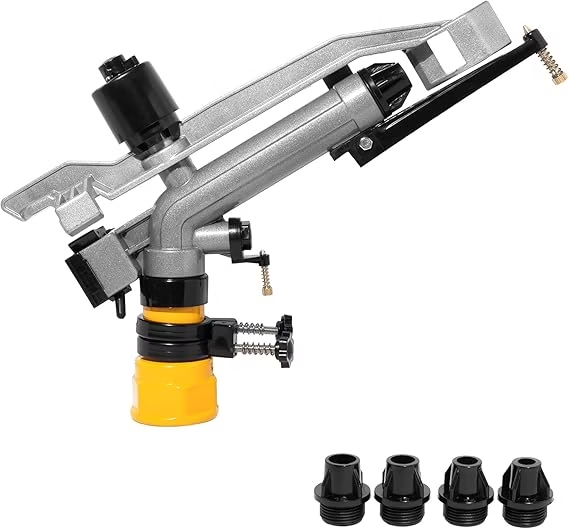
This full-circle Rain Gun is made of plastic and copper material, ensuring long-lasting durability and reliable performance with good water spraying effect.
Comes with 4 interchangeable small nozzles (12mm, 14mm, 16mm, 18mm) for customized use, bringing great convenience.
Rain Gun capacity for the submersible pump or booster pump of the sprinkler has a lift of 17–29 meters and a flow rate of 4.5–18 m³/h.
Not only 360°, this gun also has the option to adjust the spray range and angle of water for a more enjoyable and efficient garden watering experience.
Last Words…
Now you know what a Rain Gun is, its right usage, benefits, and the difference between a traditional sprinkler and the Rain Gun.
The choice between Rain Guns and traditional sprinkler systems ultimately depends on your specific needs, resources, and objectives. The main factors to consider when choosing the right option are area size, water availability, crop requirements, budget constraints, and operational preferences.
The key is selecting the right tool for your specific application and operating it efficiently to maximize benefits while minimizing resource consumption.

Leave a Reply